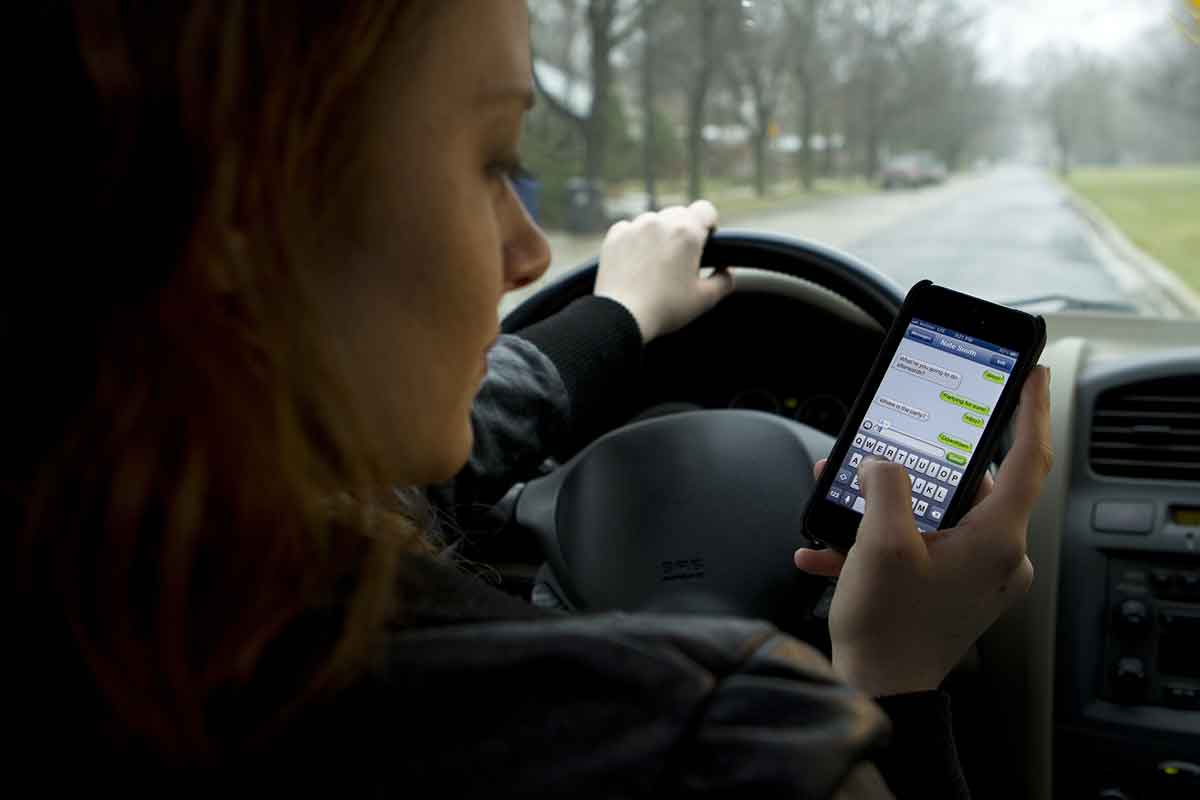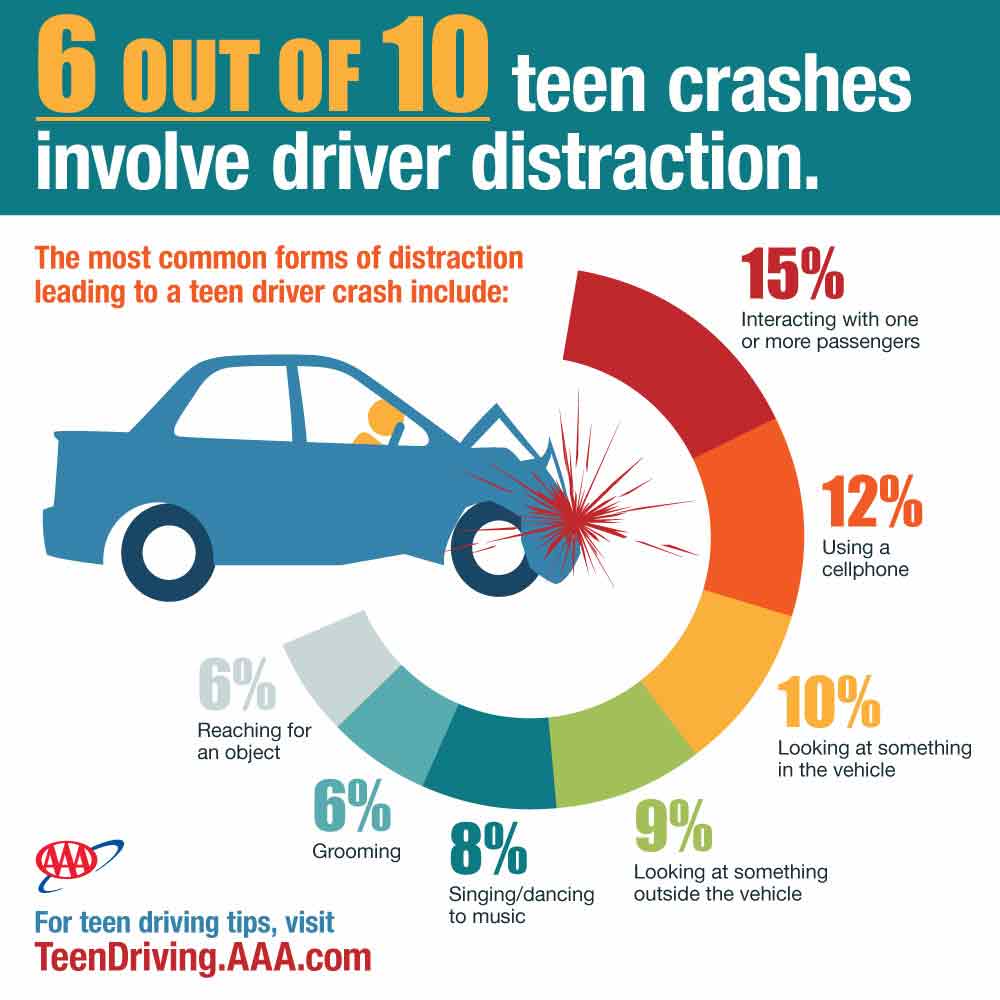Research Shows Distracted Driving is Four Times Worse Than Estimated

How many of us worry about safety knowing that there are teenagers behind the wheel of a car?
This younger generation has grown up adept at using technological devices. In fact, teenagers are so used to using handheld computers and cell phones, it is sometimes hard to regain their attention.
When you mix the inexperience of teenage drivers and their dependence on cell phones, etc… it poses a deadly mix — distracted driving!
According to the AAA Foundation for Traffic Safety’s March 2015 report, 1 teen drivers had thier eyes off the road four and one-tenth (4.1) out of the final six (6) seconds before a crash.
What were they doing? The top two reasons teens were distracted from focusing on their driving were:
- Interacting with one or more passengers – 15%
- Using their cell phone for calling, texting and other uses – 12%
The following infographic 2 from AAA outlines all causes:

This comprehensive study 3 was the result of analysis of 1,700 videos of teen drivers taken from in-vehicle event recorders over a six year period using . Lytx™, Inc., a global leader in video-based driver safety technology using in-vehicle event recorders, provided the collision videos.
The drivers in the crashes examined in the present study were not participating in a study at the time of their crashes, however, they were participating in a program intended to improve teen driver safety, and most were likely encouraged or required by their parents to participate. These results from naturalistic studies are more representative of the teen driving population, but also could underestimate the general driver population of young drivers.
The following video 4 provides a sample of those used in the study.
Teen drivers are more prone to being distracted and make poor judgment calls due to their lack of experience. In 58 percent of all teen crashes studied, distraction was a factor. Out of the 963,000 drivers age 16-19 involved in police-reported crashes in 2013, approximately 40% involved injuries and 0.3% resulted in deaths. 1
What Can Be Done To Prevent Distracted Driving?
Today’s study shows passengers and cell phones are the most common forms of distraction. In five years new distractions may appear and others may lessen. Drones flying overhead could be a new distraction. Within another decade driverless cars may eliminate most if not all of these problems.
We cannot wait another decade for this to happen. Reccomendations by AAA and AAA CEO Bob Darbelnet include:
- All state should have graduated driver licensing (GDL) laws that allow new drivers to gain practical experience in a relatively safe environment by:
- prohibiting cell phone use by teen drivers (currently only 33 states have this provsion)
- restricting passengers to one non-family member for the first six months of driving (currently only 18 states have this provsion)
- Parents should create a parent-teen driving agreement 5 that includes strict ground rules related to distraction
AAA offers a comprehensive driver education program, where teens can learn specifically how using a cell phone affects driving abilities and increases their crash risk. TeenDriving.AAA.com http://www.teendriving.aaa.com/
In summation, teen driver errors contributed to 94-99% of all teen driver crashes. The most common behavior leading up to a crash was attending to a passenger. The second most common behavior involved cell phone uses.
The information obtained in this study can help in better educating teenagers regarding unsafe behaviors while driving. Parents play a critical role in educating their teenagers to avoid cell phone useage while driving and restrict the number of passengers during their learning and early stages of driving.

We all need to help educate our children regarding the significant dangers attributed to distracted driving.
Resources from AAA and the AAA Foundation: 6
- Driver‐ZED – Interactive risk‐management training tool designed to help teens recognize how to react in a variety of driving scenarios.
- StartSmart Online Parent Session – Two-hour webinar that explains the licensing process and parents’ role, and demonstrates how to reinforce what your teen is learning in DE and how to maximize the practice driving that you’ll do with your teen.
- TeenDriving.AAA.com –AAA site that provides state‐specific information to help parents and their teens navigate the learning‐to‐drive process, and includes links to the above programs.
Sources:
1 Source Article https://newsroom.aaa.com/2015/03/distraction-teen-crashes-even-worse-thought/
2 Infographic http://newsroom.aaa.com/wp-content/uploads/2015/03/Teens-Crash-Causation.jpg
3 Full Report – Using Naturalistic Driving Data to Assess the Prevalence of Environmental Factors and Driver Behaviors in Teen Driver Crashes
4 Video samples from the AAA Foundation for Traffic Safety Report https://www.youtube.com/embed/SDWmwxQ_NnY
5 Parent-Teen Driving Agreement
6 Environmental Factors and Driver Behaviors in Teen Driver Crashes
